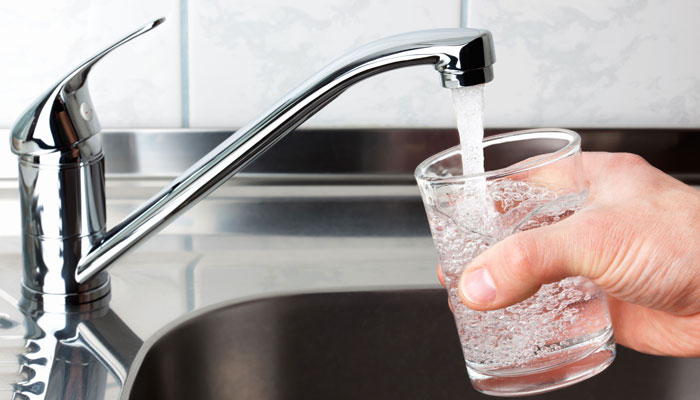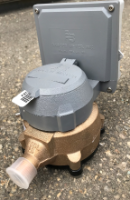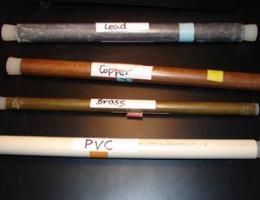Water is drawn from the Red Deer River and is purified using a multi-barrier treatment process in combination with a UV disinfection system at our water treatment plant. It is then distributed through a number of pumping stations, reservoirs and kilometers of water mains. During the year, over 25,000 water quality tests are performed on drinking water samples. The results have demonstrated that you are receiving high quality drinking water that meets or exceeds all federal and provincial standards.
Red Deer's Lead Management Program

The City is actively contacting and working with residents to check the material of water service lines and to monitor lead levels in drinking water.
The drinking water leaving the Water Treatment Plant and in the distribution system is lead free. However, lead may be present in household tap water due to its presence in the service connection or in household plumbing systems containing lead, including solder and brass fittings.
We began testing for lead within the distribution system in the Fall of 2009 and the average of our results is less than the method detection limit of 0.0005 mg/L, well within the Health Canada guidelines of 0.005 mg/L.
Lead enters drinking water as a result of corrosion over a long period of time. If standing water (e.g. overnight) is in contact with lead materials for several hours, the water may accumulate lead levels that could become a concern.
The most common sources are:
- Lead-based solder used to join copper pipe, faucets made of brass and chrome-plated brass, and in some cases, pipes made of lead that connect a home to the water main (service lines).
- Lead paint and the contaminated dust and soil it generates are the primary source of lead exposure in older housing.
Lead has historically been used as a component of paint, piping, solder, brass, and as a gasoline additive.
Homes constructed before 1960 may have lead water service lines. Both lead and copper piping were used up until this time, when copper water service lines became the standard in the plumbing industry. Lead based solder can be another source of lead in drinking water, as this type of solder was used for plumbing until the mid-to-late eighties.
Most residential properties with lead service lines have 5/8” (16 mm) diameter water pipes. If your home has been renovated, the water service line may have been replaced with 3/4” (19 mm) diameter pipes, which would provide more consistent water pressure and higher flow rates.
- Locate the water meter (usually found in the basement; pictured here)

- Look at the pipe coming up through the basement floor into the bottom of the water meter
- If it is lead, you will notice the pipe is:
- grey in colour;
- does not echo if you gently strike it;
- scratches easily;
- leaves metallic marks when you rub the scratched area against paper.

Note: Service line piping can also be made of polyethylene (black) or polybutylene (black or blue).
The Municipal Government Act makes you, the residential property owner, responsible for the water service connection on your property as well as the plumbing in your home. Typically, lead service connections are found in older homes built before 1960. The City is responsible for the service connection pipes between the property line and the water main in the street.
Adjusting the Water Treatment
Unbalanced and corrosive water can cause lead leaching to occur in old pipes or in pipes constructed using solder on fittings with high lead content. We reduce drinking water corrosivity by using sodium hydroxide to adjust the pH, which is completely safe for consumption. Water that is more alkaline (i.e. pH above 7) will produce a protective scale, which will coat the inside of the pipe, helping to minimize lead leaching.
Education and Awareness
The City provides public education and awareness programs to inform residents who may be affected by lead service pipes. A letter was delivered to all the homes in Red Deer built prior to 1960, informing residents of the potential health risks, and links for additional information. The City of Red Deer website is also used to communicate with residents regarding this important topic.
How can I limit my exposure to lead?
If you are concerned about lead in your drinking water, take the following preventive steps to further limit possible exposure:
- Flush standing water in pipes each morning to clear water from the plumbing and home service line to ensure the drinking water comes from the main service line. Do this by:
- Flushing the toilet;
- Washing your hands; or
- Letting the water run for five minutes or until it is cold to the touch.
- Use cold water for drinking and cooking. Hot water dissolves more lead from plumbing. Boiling water DOES NOT remove lead.
- Some home water treatment devices remove lead, but not all do. Always check the model specifications before buying.
- Participate in The City of Red Deer’s Lead Program to determine if your home has a lead water service line. If a line is present, it does not necessarily mean lead is in the water, but that the potential exists.
How can I test my water for lead?
You cannot see, smell or taste lead in water. Laboratory testing of water from the tap is the only way to determine the lead levels in your drinking water. Our goal is to determine which homes have lead services lines, or are likely to, and to test the water accordingly. Timeframes are limited, as testing is recommended during warm water periods of July through September.
You can also arrange for testing by an accredited and licensed private laboratory.
If my house was found to have lead service pipes and water samples have been taken, can I receive the results of the testing?
Yes, contact Utility Services at 403-342-8750 to request the results. It will take several weeks after the samples are taken before results can be provided and information will only be released to the homeowner.